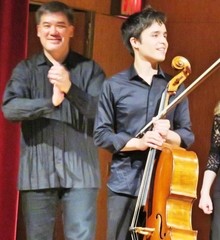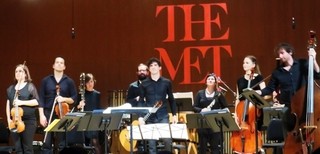|
Back
Campbell and Gilbert Give The Silent Treatment New York
Grace Rainey Rogers Auditorium
06/04/2016 -
NY Phil Second Biennial: “Ligeti Forward”
Marc-André Dalbavie: Axiom
György Ligeti: Cello Concerto
Dai Fujikura: ice
Jay Campbell (Cello)
Artists of the Lucerne Festival Alumni, David Fulmer, Alan Gilbert (Conductors)

A. Gilbert, J. Campbell (© Samuel A. Dog)
“pppppppp”
György Ligeti: First-measures dynamic marking for Cello Concerto
On yesterday’s so sad day, two memories were etched into my mind. That morning, I had recalled, in 1975, taking the late Mohammed Ali on a tour through Kuala Lumpur, after covering him in a heavyweight championship bout. The man’s grace, graciousness, his innate kindness to everybody he met was like music itself. And where the various entourages had complained about the heat, Mohammed Ali simply enjoyed the torrid sun as much as the adulation.
The next memory came yesterday evening as Jay Campbell started to play György Ligeti’s Cello Concerto, I remember an equally momentous scene two years ago uptown in Symphony Space. Krystzof Penderecki had written a cello Capriccio for Siegfried Palm which was almost unplayable. That night, Jay Campbell with the most unassuming pleasure, played the same work and Penderecki himself was in the audience. It was an astounding piece on Mr. Palm’s recording. But watching Mr. Campbell, looking like an errant schoolboy, play those sounds in a whirlwind of notes was almost as fascinating as watching Penderecki lose his stolid objective observation and burst into a wide grin and then a laugh.
“Never have I heard this played so well,” he said. He was frankly dazzled.
But that is Jay Campbell, for whom the cello is meant to either dazzle–or, as last night–to be an instrument combining mystic mantras with quantum physics equations.
The Ligeti Cello Concerto (also written for Siegfried Palm) is the opposite of Ligeti’s Piano Concerto, played the night before. The latter was extrovert, crazy, a tsunami of notes and meters, polytonal and loud, polyrhythmic and poly-emotional. Not for the save of bravura, but for Ligeti’s conception.
The Cello Concerto started with that previously quoted pppppppp on the E string, and hardly ever let up during the first two movements. Where the Piano Concerto deserved a full auditorium, the Cello Concerto need a hushed salon, a group of perhaps two-dozen listeners. And anybody who coughed or even breathed would be shot by firing squad. (After the music, of course.)
Alan Gilbert conducted the small orchestral group with his usual baton-less finesse. But all ears were on what could hardly be heard at all. Mr. Campbell began on single note, turned it, with the orchestra, into a intense harmonic structure–a structure into which we, the audience, were invited–loosened it oh so subtly, and then Mr. Campbell literally whispered his cello into the second movement.
At that point, both Campbell and Gilbert let Ligeti do all the work. With immeasurably tiny steps, the composer jolted us with a few wildly oscillating passages, and then, like an atom suddenly split, brought us into total silence.
Oh, not total silence. Mr. Campbell played the “whispering cadenza”, another virtually soundless configuration where one knew there was music only because his fingers were moving frantically along the fingerboard.
At the end, one had heard not a concerto per se, like the Piano Concerto or Sunday afternoon’s Violin Concerto. But a tribute, an homage to what we don’t hear.
Lawrence Durrell once noted, “Everything which moves depends on the silence around us.” Jay Campbell, Alan Gilbert and György Ligeti were close to silence. And we were indeed moved.
The Ligeti was the centerpiece of the second “Ligeti Forward” series of the NY Phil Biennial. The evening began with a work which was obviously 21st Century–yet with passages that seamlessly could have passed as late Lisztian 19th Century. Axiom commenced with (and continued throughout) a slow octave melody on the piano. A motive which descended mainly in fourths. Then repeated in quarter notes, then eighth-notes and then a whole scale-full of 32nd notes of that same melody.
This was virtuosity by itself–though those fast downward notes could have prefaced the climax of a Liszt piano concerto. Not to worry. Soon some winds chimed in with the same intervallic melody, themselves crashing onto themselves with greater and greater speed–until the music reversed itself, those high-velocity tones going up, then down again, faster and faster.
Such a simple idea, done with such brilliant technique. A work which Ligeti himself would have loved. (In fact, I just heard that Dalbavie had dedicated the work to Ligeti. Perfectly fitting, since it encompassed mathematics, complexity disguising simplicity, and a joy to hear.)

Lucerne Festival Alumni (© Samuel A. Dog)
The evening ended with ice by Dai Fujikura, a composer of infinite possibilities. I had previously heard his incredibly difficult work piano work played by Taka Kigawa, and another orchestral work about womb gestation. All of these were interesting and intriguing.
I suppose that ice was amazing, for Fujikura worked in the strangest sounds with the Lucerne Festival Alumni. Buzzing and oscillating, vibrating, vacillating. I would like to say that the orchestra was blowing hot and cold. But with the title ice, I gathered that it was mainly cold. Especially with a long long solo bass flute at the end, which could have been dripping from last cube in the ice tray. The composer Varese would have been highly impressed at the orchestration of temperature.
Or perhaps this was Mr. Fujikura’s way of saying, “Now if ice could speak, this is what it would say.” With no program notes at all, I can only guess that this was the purpose, and if so, Mr. Fujikura succeeded. Though perhaps he meant something entirely different.
If so, still give him not only credit for invention. Thanks to the title, it’s the thawed which counts.
Harry Rolnick
|